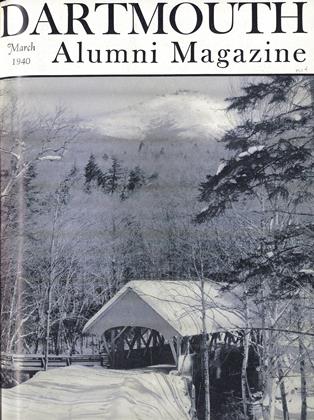by MarshallMcClintock '26, illustrated by NinonMcKnight. The Vanguard Press, NewYork, 1939. 105 pages. $2.00.
If more writers of children's books would follow the example of Marshall McClintock and write intelligent material, with well worked-out backgrounds, the children's book field would soon lose that piffling caption of "Juvenile." "Here Is a Book" has the fascinating background of a printing office, limited at the beginning, but blossoming into a real shop at the end of the story. This book is written for young people between the ages of 8 and 80 and has a genuinely original conception in the double significance of the title. For half the book is devoted to the printing and publishing business, the stages that a manuscript goes through after an author has an idea, the kinds of type,— elemental faces that all readers ought to know, the processes of printing and color illustration. A fine book for institutions, libraries as well as schools,—for these constitute at least 75 per cent of the sales in the children's book field.
The popularized version of treating copy, with good illustrations, is followed by the story, a really good story, which is not "written down" in any sense. It tells of the efforts of two boys and a girl to get out a newspaper, who win over the editor of the local newspaper and get his help in securing a press. It gives also a scheme for the publication by young people of a gossipy paper in a small town or city. The young folks learn a rather valuable lesson in the first few attempts, chiefly that local news is read with more interest than the general run of national news, and they find that a newspaper makes enemies when it tries to print impartial news. A much read story which gave the paper popularity and also made an enemy was the paragraph describing the identification of a clothes-line thief, who turned out to be the pet dog of a certain prominent Milton family. The Foxtown Flash came in for criticism, but it also turned in fifteen cents.
Flow the Flash grew, its great Scoop, and the benefit performance brought about by the girl reporter,—all these may be learned from reading the book. The reviewer happens to be more interested in this type of writing than any other, and is always rejoiced to see newcomers take it up and work upon it, because the usual (and wrong) idea of books for children is that "anything will do." A writer of children's books does not grow up into the adult field; often writers from the Adult Field will try books for children and wonder why they failed. Librarians, teachers, readers who liked the old Youth's Companion and St. Nicholas, are all on the lookout for books of this type, to add to the list of much read volumes. When modern problem stories supplant in interest Robinson Crusoe, Baron Munchausen, Fluckleberry Finn, Treasure Island, Little Women, or even the Iliad and Odyssey, then it will be time for us all to quit the field of children's books. Till then, Mr. McClintock, please go right straight on.
 View Full Issue
View Full Issue
More From This Issue
-
 Article
ArticleEducation At Its Best
March 1940 By ARTHUR DEWING '25 -
 Sports
SportsBig Green Teams
March 1940 By Whitey Fuller '37 -
 Article
ArticleAn Obligation to Alumni
March 1940 By BEN AMES WILLIAMS '10 -
 Article
ArticleHanover Browsing
March 1940 By HERBERT F. WEST '22 -
 Class Notes
Class Notes1930*
March 1940 By ALBERT I. DICKERSON -
 Article
ArticleThe College in the Sixties
March 1940 By DR. WILLIAM LELAND HOLT
E. P. Kelly '06
Books
-
 Books
BooksTHE AUTOBIOGRAPHY OF JOHANNES BUTZBACH, A WANDERING SCHOLAR OF THE FIFTEENTH CENTURY.
June 1936 By Ashley K. Hardy '94 -
 Books
BooksMORE THAN MERE LIVING,
May 1940 By F. L. Childs '06 -
 Books
BooksStar-Studded Life
February 1976 By J.B. WATSON JR. -
 Books
BooksBOSWELL IN SEARCH OF A WIFE, 1766-1769. Edited
January 1957 By JOHN HURD '21 -
 Books
BooksCAUSAL INFERENCES IN NON EXPERIMENTAL RESEARCH.
APRIL 1965 By ROBERT SOKOL -
 Books
BooksTHE CHANGES.
JULY 1965 By THOMAS A. CARNICELLI





